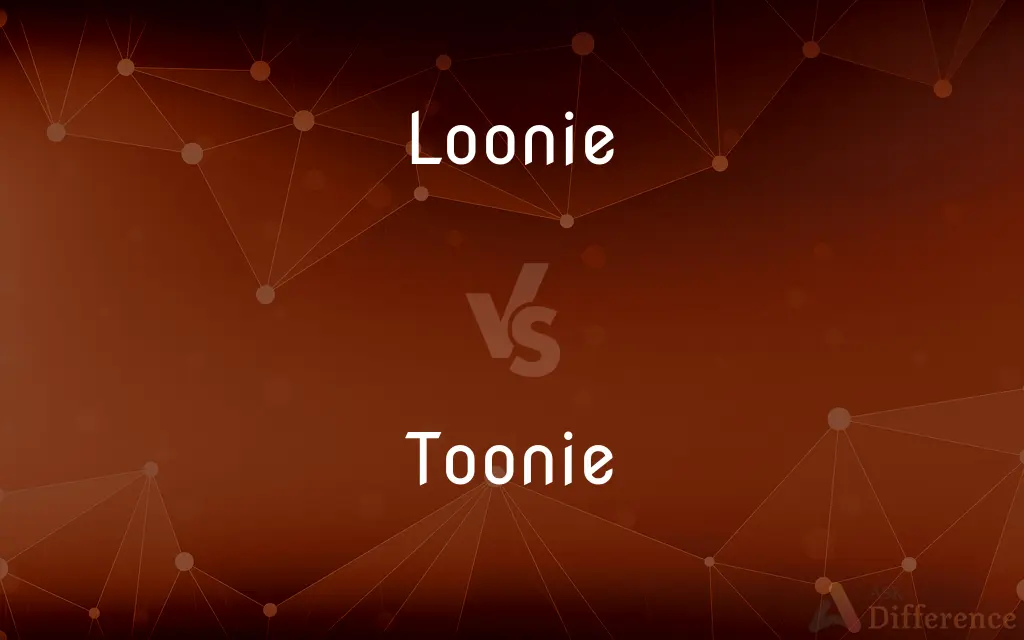Loonie vs. Toonie — What's the Difference?
By Urooj Arif & Maham Liaqat — Updated on April 4, 2024
Loonie is Canada's $1 coin, featuring a loon; Toonie is the $2 coin, notable for its bi-metallic design.

Difference Between Loonie and Toonie
Table of Contents
ADVERTISEMENT
Key Differences
The Loonie, introduced in 1987, is the colloquial term for Canada's one-dollar coin. Its name derives from the image of a common loon, a bird found across Canada, depicted on the coin's reverse side. This coin marked a significant change in Canadian currency by replacing the one-dollar bill. Whereas, the Toonie, introduced in 1996, is the informal name for the Canadian two-dollar coin. It is distinguished by its bi-metallic composition, featuring two different colors of metal, and was introduced to provide a higher value coin in a convenient form. The Toonie's name is a playful portmanteau of "two" and "loonie," suggesting its value as two Loonies.
While the Loonie's introduction was primarily to reduce the cost of producing dollar bills, the Toonie was introduced not only for economic reasons but also to facilitate transactions that increasingly required coins of higher value. The Loonie's singular metal design contrasts with the Toonie's more complex bi-metallic composition, which includes a central core and an outer ring made of different metals, making the Toonie more durable and distinctive in appearance.
The Loonie and Toonie both feature iconic Canadian symbols on their reverse sides, reflecting Canada's natural heritage and identity. However, the Toonie's design also includes representation of the polar bear, another symbol of Canada's arctic fauna, highlighting the country's commitment to its natural heritage and environmental conservation.
Despite their different values, both coins play crucial roles in Canada's currency system, facilitating everyday transactions. The adoption of these coins reflects broader trends in Canadian monetary policy, including the phasing out of lower denomination notes and the emphasis on durable coinage to reduce long-term costs.
The introduction of the Loonie and Toonie has also had cultural implications, with both coins becoming embedded in Canadian vernacular and identity. They are often used in promotional and commemorative contexts, celebrating Canadian achievements, culture, and milestones.
ADVERTISEMENT
Comparison Chart
Introduction
1987
1996
Value
$1
$2
Design
Single metal, features a loon.
Bi-metallic, features a polar bear.
Purpose
Replace one-dollar bill, reduce production costs.
Facilitate transactions, durable design.
Symbolism
Common loon, Canadian nature.
Polar bear, Canadian Arctic, environmental conservation.
Durability
Durable, but single-metal composition.
More durable due to bi-metallic composition.
Cultural Role
Became a symbol of Canadian currency and nature.
Symbolizes Canadian innovation and commitment to nature.
Compare with Definitions
Loonie
Canada's $1 coin.
I used a Loonie to pay for parking.
Toonie
Bi-metallic design.
The Toonie's unique look comes from its two types of metal.
Loonie
Features a common loon.
The Loonie gets its name from the loon pictured on it.
Toonie
Canada's $2 coin.
The Toonie is worth two Loonies.
Loonie
Used in various transactions.
Vending machines in Canada accept Loonies.
Toonie
Introduced in 1996.
Canada introduced the Toonie to facilitate larger transactions.
Loonie
Symbol of Canadian nature.
The Loonie reflects Canada's rich natural heritage.
Toonie
Features a polar bear.
The Toonie showcases a polar bear, symbolizing the Arctic.
Loonie
Introduced in 1987.
The Loonie replaced the one-dollar bill in 1987.
Toonie
Represents innovation.
The Toonie's design reflects Canadian innovation in currency.
Loonie
The loonie (French: huard), formally the Canadian one-dollar coin, is a gold-coloured coin of the Canadian dollar that was introduced in 1987 and is produced by the Royal Canadian Mint at its facility in Winnipeg. The most prevalent versions of the coin show a common loon, a bird found throughout Canada, on the reverse and Queen Elizabeth II, the nation's head of state, on the obverse.
Toonie
The toonie (also spelled twonie or twoonie), formally the Canadian two-dollar coin (French: pièce de 2 dollars canadiens, nicknamed deux piastres or deux piastres rond), was introduced on February 19, 1996, by Minister of Public Works Diane Marleau. As of 2019, it possesses the highest monetary value of any circulating Canadian coin.
Loonie
A Canadian coin worth one dollar.
Toonie
A Canadian coin worth two dollars.
Loonie
The Canadian dollar.
Toonie
A Canadian two-dollar coin.
Loonie
The Canadian dollar coin in common circulation since 1987.
Loonie
The dollar as the Canadian unit of currency.
The loonie continued to rise against the greenback today.
Common Curiosities
Can you use Loonies and Toonies in all Canadian vending machines?
Yes, Loonies and Toonies are widely accepted in Canadian vending machines and parking meters.
How did the Loonie get its name?
From the image of a loon on its reverse side, reflecting Canadian wildlife.
Why does the Toonie feature a polar bear?
The polar bear symbolizes Canada's Arctic region and environmental consciousness.
What makes the Toonie's design unique?
Its bi-metallic composition, featuring two different metals for durability and distinctiveness.
What is the significance of the Loonie and Toonie to Canadian culture?
They are symbols of Canadian identity, innovation, and the country's natural heritage.
Have there been any special editions of the Loonie and Toonie?
Yes, Canada has issued commemorative editions to celebrate significant events and milestones.
Why was the Loonie introduced?
To replace the one-dollar bill, reducing production and replacement costs.
Are Loonies and Toonies accepted outside Canada?
While primarily used within Canada, they may be exchanged at currency exchanges worldwide.
Can the designs on the Loonie and Toonie change?
Yes, while the main themes remain constant, special editions feature varying designs.
How do Loonies and Toonies contribute to the Canadian economy?
They help reduce the costs associated with paper money and facilitate everyday transactions.
What role do Loonies and Toonies play in Canadian traditions?
They are often used in rituals like the "loonie toss" at events, embedding them further into Canadian culture.
Is there any environmental significance to the symbols on the coins?
Yes, both the loon and the polar bear highlight Canada's commitment to preserving its natural environment.
How do tourists react to using Loonies and Toonies?
Tourists often find the coins interesting and distinctive aspects of Canadian currency, adding to their travel experience.
What is the life expectancy of a Loonie vs. a Toonie?
Both coins are designed for long-term use, but the Toonie's bi-metallic design may offer greater durability.
How does the public perceive the introduction of the Toonie?
Initially met with skepticism, the Toonie has become a valued part of Canadian currency for its convenience and durability.
Share Your Discovery

Previous Comparison
Lariat vs. Clothesline
Next Comparison
Joy vs. HappinessAuthor Spotlight
Written by
Urooj ArifUrooj is a skilled content writer at Ask Difference, known for her exceptional ability to simplify complex topics into engaging and informative content. With a passion for research and a flair for clear, concise writing, she consistently delivers articles that resonate with our diverse audience.
Co-written by
Maham Liaqat













































